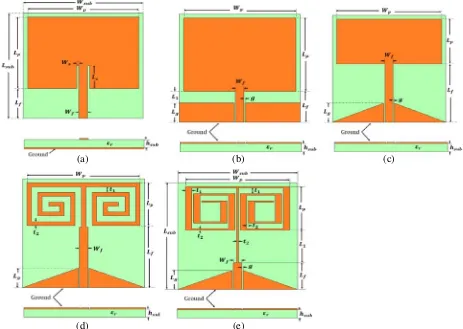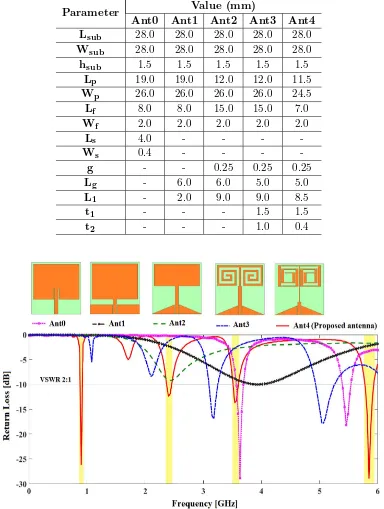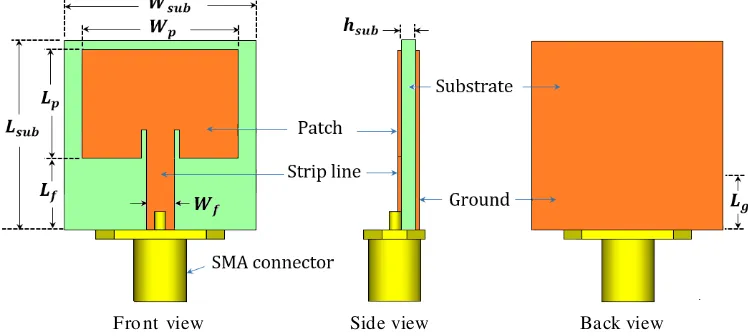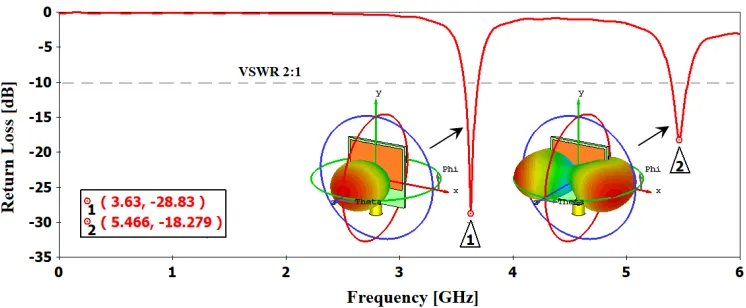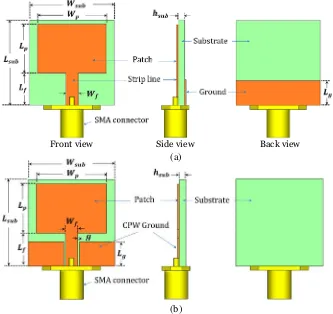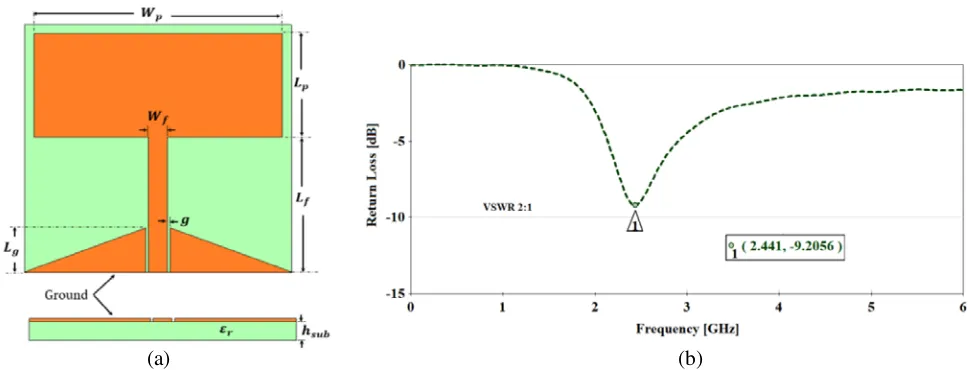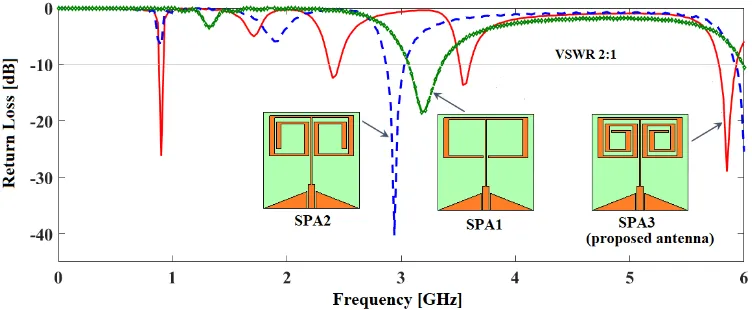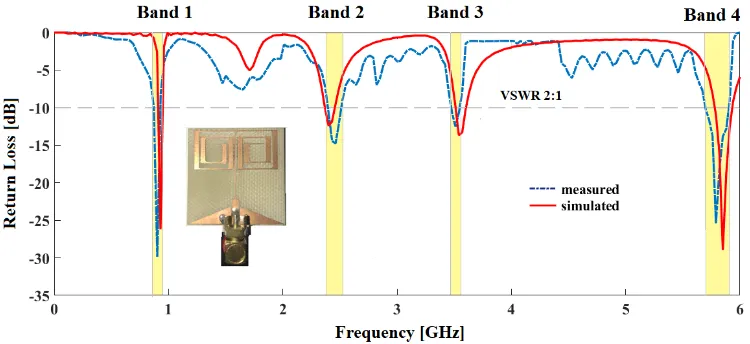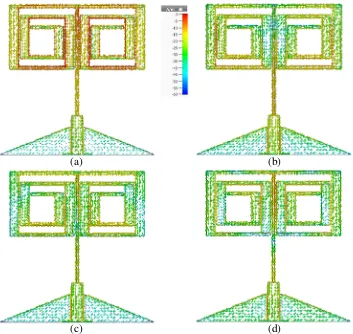Design of Miniaturized Quad-Band Dual-Arm Spiral Patch Antenna
for RFID, WLAN and WiMAX Applications
Ayia A. S. A. Jabar and Dhirgham K. Naji*
Abstract—In this paper, a new design approach is presented for achieving a miniaturized quad-band microstrip patch antenna (MPA) suitable to be used for 915-MHz (UHF band), 2.45- and 5.8-GHz (ISM band), and 3.5-GHz (WiMAX band). The proposed antenna is called modified square spiral antenna (MSSA) which is composed of a modified dual-arm square spiral patch strip structure and a tapered-ground plane with coplanar wave-guide (CPW)-fed configuration to feed this antenna, all printed on the top side of an FR4 substrate. The proposed antenna is designed through intermediate systematic design steps of antennas starting from a conventional strip-fed rectangular MPA and ending by achieving MSSA. A CST Microwave Studio (CST MWS) is used to model the designed antenna, and simulation results, in terms of return loss (S11), realized peak gain and efficiency, besides radiation patterns, are obtained.
To validate the design concept, the antenna structure is fabricated, and the simulated and measured
S11results nearly coincide with each other. The proposed antenna is characterized by miniaturized size
of 28×28 mm2, and based on measured −10-dB S11 result, MSSA has four bands, band 1: 915 MHz
(872–929 MHz), band 2: 2.45-GHz (2395–2510 MHz), band 3: 3.5-GHz (3470–3550 MHz), and band 4: 5.8-GHz (5698–5900 MHz).
1. INTRODUCTION
It is well known that one of the important electrical devices, which receives and/or transmits information through space is antenna. Recently, there has been increasing interest for multiband, omnidirectional antennas characterized by miniaturized size and simple realization to meet the requirements needed by modern standard wireless communication systems. These communication standards are accessed daily by people over the world, such as Radio Frequency Identifications (RFID), Wireless Local Area Network (WLAN), Bluetooth-enabled devices, satellite communications, the fifth-generation (5G) cellular networks, and Worldwide Interoperability for Microwave Access (WiMAX). [1]. Thus, multiband antenna should cover the desired bands allocated for these standards, 915 MHz (860–960 MHz), 2.45 GHz (2.4–2.5 GHz), 5.8 GHz (5.725–5.875 GHz) for RFID and WLAN bands, 3.5 GHz (3.4–3.6 GHz) for 5G and WiMAX band, etc.
Three main types of multiband printed antennas that have been reported in the recent few years to satisfy the aforementioned bands with compact size are monopole antennas (MAs), slot antennas (SAs), and patch antennas (PAs) [2–11]. The conventional technique for realizing multiband characteristics to these antennas is either by addition of multi-radiating elements to the patch of MS [2–5] and PA [6–8] or inserting slots or notches in the radiating element of SA [9–11]. The idea behind this technique is getting different current paths at the surface of these antennas that lead to resonating at various frequencies.
Received 17 January 2019, Accepted 1 March 2019, Scheduled 21 March 2019
* Corresponding author: Dhirgham Kamal Naji (dknaji73@yahoo.com).
It is known that the dominant resonant frequency for most of the antennas is so far dependent on the physical dimension of their radiating elements and subsequently limits the antenna miniaturization to a certain extent. Hence, the design of miniaturized multiband antennas is highly attractive, and persistent attempts for new solutions and approaches are presented by researchers, in particular for antennas operating at lower frequency bands [12–17]. In [12], a slotted triangular MA was presented to cover dual bands used for RFID systems and operated in the frequency ranges of (0.797–1.004 GHz) and (2.234–2.934 GHz). A compact coplanar waveguide (CPW)-fed folded SA with overall dimensions of 30×30 mm2was proposed in [13] to operate at four bands for 0.94/2.45/5.8-GHz RFID and 2.45/3.5/5.5-GHz WiMAX/WLAN applications. In this design, to achieve multiband operation with miniaturize size, three slots and four L-shaped and two U- and F-shaped branches were used as additional resonators. In [14], a printed planar spiral-shaped folded strip MA was proposed for resonating at different frequency bands between 0.5 and 5.6 GHz suitable for low frequency biomedical band besides other wireless bands such as Bluetooth, WLAN, ZigBee, and LTE bands. CPW-fed technique was used to excite this antenna, and the width of spiral strip was controlled to vary within the restricted size 23×40 mm2of the optimized antenna for getting the desired bands. The antenna presented in [15] was optimized to operate effectively in ISM bands (2.4 and 5.8 GHz), as well in 5G bans (0.7 and 3.5 GHz). A CPW was used for feeding this antenna which comprises one circular disc and two circular rings, and its overall dimensions are 175 mm×105 mm. A multiband Koch fractal PA is proposed in [16] for operating at triple frequency bands, 915 MHz, 2.45 GHz, and 5.8 GHz. A miniaturized metamaterial based MA was designed in [17] to operate at cellular standards such as GSM 900 (0.9 GHz), Wi-Fi (2.5 GHz), and WiMAX (3.5 GHz). To shift the resonance frequency for the lower band to 0.9 GHz, an additional layer (copper) was connected via shorting pin to the antenna radiating layer resulting in reduction in electrical size about 76% of the proposed design. Although most of the aforementioned designed antennas have achieved multiband characteristics, they are either large in size or complex in geometrical structure.
In this paper, a new design approach is presented for achieving a miniaturized quad-band microstrip patch antenna (MPA) suitable for 0.915/2.45/5.8-GHz RFID tag and 2.45/3.5-GHz WiMAX/WLAN applications. The proposed antenna is called modified square spiral antenna (MSSA) and has a size of 28×28 mm2. A CST Microwave Studio (CST MWS) is used to model the designed antenna. A simulation result in terms of return loss (S11) is compared with the measured result, and a good agreement between
them has been obtained. Then the simulation results for the proposed antenna, including return loss, surface current distribution, gain, and efficiency besides the radiation pattern at the specified resonance frequencies, are discussed.
2. GEOMETRY OF THE PROPOSED ANTENNA
The 3D simulation model and fabricated structure of the finalized proposed designed antenna, modified square spiral antenna (MSSA), is shown in Figure 1. The antenna is printed on the front side of an FR4 substrate (Lsub×Wsub) of (28 mm×28 mm) with thickness hsub of 1.6 mm and relative permittivity r = 4.3. The FR4 substrate is available in the Lab, and it is used to fabricate the proposed antenna. The authors aware that there are low-cost substrates, such as Kappa 438 and ISOLA A380, and they may be used for better quality factor, improving antenna input return loss (selectivity). However, these materials are not available in our fabrication lab. The patch of antenna, length (Lp = 11.5 mm)× width (Wp= 24.5 mm) is inscribed with a modified dual-arm spiral strip configuration connected to the coplanar waveguide (CPW) structure via a strip of length L1 and widtht2. The vertical (horizontal)
spiral’s width ist1(t2) whereas the spacing between them ist2(t1). The tapered ground plane has length
Lg, and the length (width) of CPW is represented by symbols Lf (Wf = 2 mm) for feeding antenna through a sub-miniature-A (SMA) connector. Table 1 lists the optimized values of antenna parameters.
3. DESIGN PROCEDURE
(b) (a)
Figure 1. Configuration of the proposed antenna, MSSA. (a) 3D simulation model. (b) Fabricated structure.
(b) (a)
(d)
(c)
(e)
The first designed antenna, as shown in Figure 2(a), is a conventional strip-fed MPA (Ant0) designed by applying equations of the transmission line model to resonate at 3.5-GHz WiMAX band. Then intermediately designed CPW-fed MPAs are obtained during the design procedure until achieving MSSA (Ant4) that has the desired operating frequency bands. Table 1 shows the parameter values of the designed antennas (Ant0–Abt4) while Figure 3 shows their CST simulated return loss (S11) results.
The next sections describe and investigate in detail the design procedure for these antennas as well their simulation S11 results.
Table 1. The final dimensions of the designed antennas.
Parameter Value (mm)
Ant0 Ant1 Ant2 Ant3 Ant4 Lsub 28.0 28.0 28.0 28.0 28.0
Wsub 28.0 28.0 28.0 28.0 28.0
hsub 1.5 1.5 1.5 1.5 1.5
Lp 19.0 19.0 12.0 12.0 11.5
Wp 26.0 26.0 26.0 26.0 24.5
Lf 8.0 8.0 15.0 15.0 7.0
Wf 2.0 2.0 2.0 2.0 2.0
Ls 4.0 - - -
-Ws 0.4 - - -
-g - - 0.25 0.25 0.25
Lg - 6.0 6.0 5.0 5.0
L1 - 2.0 9.0 9.0 8.5
t1 - - - 1.5 1.5
t2 - - - 1.0 0.4
3.1. Design of the Conventional MPA
As stated in the previous section, for achieving the antenna having both miniaturized size and desired multiband operation for covering sub-6 GHz frequency bands, a conventional strip-fed rectangular MPA (Ant0) is considered as a good choice to begin with. To do that, transmission line equations, Eqs. (1)– (4), are used for designing the conventional strip-fed rectangular MPA [18]
εeff = ε
r+ 1
2 +
εr−1 2
1
1 + 12h/W
(1)
whereεr, h, W are dielectric constant, height of the substrate, and width of the substrate, consecutively.
The length and width of antenna identify antenna resonance. The width of antenna for dominant mode resonance is given as:
L= 1
2fr√εeff√μ0ε0 −
2ΔL (2)
where,
ΔL= 0.412h(εeff + 0.300) (εeff −0.258)
W
h + 0.262
W
h + 0.813
(3)
Here cis the speed of light in space, and fr is the resonance frequency of antenna. The width of patch antenna is given by
W = c 2fr
2
εr+ 1 (4)
By applying these equations, the geometrical parameters, patch width (Wp = 26.32 mm), and patch length (Lp = 19.26 mm) of the conventional MPA have been calculated by assuming the resonant frequencyfr= 3.5 GHz (WiMAX band), and the relative permittivity is given as εr= 4.3 (FR4) while the height of the substrate is hsub = 1.5 mm. Then, an inset-fed MPA (length Ls and width Ws),
as illustrated in Figure 4, is simulated by employing the full wave electromagnetic CST MWS with the calculated values of Lp and Wp described above as an initial length and width of the rectangular
patch antenna connected to the 50 Ω SMA through the stripline of length Lf and width Wf = 2 mm.
After fine-tuning the antennas’ geometrical parameters, the optimized values of these parameters are listed in Table 1. As shown in Figure 5, the simulated return loss of the conventional designed antenna operates at dual-frequency bands with resonance frequencies fr1 = 3.6 GHz and fr2 = 5.4 GHz with
Fro nt view Side view Back view
Figure 5. S11plot and radiation pattern for the conventional inset-fed MPA.
−10-dB S11 bandwidth of 200 MHz for the first band (3.5 GHz–3.7 GHz) and 170 MHz for the second
band (5.37 GHz–5.54 GHz). The total radiation is in the front direction of antenna in 3.6 GHz and in the right and left side directions of antenna in 5.4 GHz. This antenna has patch dimensions (Lp×Wp) of (19 mm×26 mm), and the total substrate dimensions (Lsub×Wsub) are (28 mm×28 mm).
3.2. Design of a Reference Antenna
The conventional MPA has been successively designed based on Eqs. (1)–(4) to operate at the desired resonance frequency fr = 3.5 GHz. A reference antenna (RA) with tapered ground plane and fed by CPW technique is required to be resonated at fr ∼= 2.45 GHz (RFID and WLAN bands). To do that, initially, a previously microstrip-fed antenna is redesigned with the same geometrical parameters except using a partial ground of length Lg at the back side of the substrate, as shown in Figure 6(a). Later on, a microstrip antenna with strip feed is replaced by a counterpart CPW feed to produce the desired reference antenna (RA) or Ant1 as shown in Figure 6(b).
Figure 7 shows the return loss plot for applying both the CPW feed and microstrip feed to the designed antennas. It can be noticed that the strip-fed conventional MPA with ground (partial ground) has lower resonant frequencyfrof 3.63 GHz atS11=−28.83 dB (3.95 GHz atS11=−6.59 dB), whereas
the CPW-fed reference antenna (RA) resonates at fr = 3.92 GHz atS11 of −9.8 dB. After that
CPW-fed RA is designed from the conventional strip-CPW-fed MPA to operate at 3.92 GHz, the RA is redesigned to resonate at fr= 2.45 GHz.
3.3. Design of a CPW-Fed Tapered Ground MPA
Figure 8(a) shows the designed CPW-fed tapered ground plane (Ant2) which has the same geometrical parameters of its counterpart Ant1 except usingLp of 12 mm instead of 19 mm as in Ant1. The return
loss performance of RA is plotted in Figure 8(b). It is seen from this figure that this antenna resonates at 2.44 GHz at S11 = −9.2 dB. This antenna is used in the preceding evolution design process for
designing the proposed antenna.
3.4. Dual and Modified Dual-Arm Square Spiral Patch Antennas
Depending on the previous designed antenna, Ant3 is evolved from Ant2 by forming its patch as a spiral strip having widtht1= 1.0 mm, and the spacing between the stripst2 is 0.5 mm. This antenna is called
square spiral antenna (SSA) and shown in Figure 9(a).
Front view Side view Back view
(b) (a)
Figure 6. (a) Microstrip-fed MPA with partial ground. (b) CPW-fed MPA, the reference antenna (RA), Ant1.
Figure 7. CST simulated return loss curves of various antennas.
four frequencies (i.e., 0.90 GHz, 2.41 GHz, 3.54 GHz, and 5.85 GHz) with matching less than −10 dB as shown in Figure 10. The return loss of the designed antennas is plotted in Figure 10, and the summarized results for the five designed antennas in terms of the jth lower, higher, and resonance frequency fLj, fHj, and frj, respectively, are illustrated in Table 2.
3.5. The Operating Concept of Quad-Band Antenna
(b) (a)
Figure 8. The CPW-fed MPA with tapered ground plane (Ant2) (a) and its plot of return loss against frequency (b).
(b) (a)
Figure 9. (a) The ordinary dual-arm square spiral antenna (SSA), Ant3. (b) The modified square spiral antenna (MSS), Ant4.
Table 2. The simulated and measured frequency bands of optimized antenna. Unit in [MHz].
Band number j Simulation result Measurement result fLj fHj frj fLj fHj frj
1 890 935 910 872 929 900
2 2368 2455 2410 2394 2510 2460
3 3510 3600 3550 3474 3547 3510
4 5780 5930 5850 5697 5903 5790
Figures 11(a)–(c) depict these three design steps as evolution process to attain SPA3 as the proposed antenna. Figure 12 shows the simulated return loss results for these antennas. It is seen from this figure that−10-dBS11return loss of SPA3 covers four different frequency bands whereas both antennas SPA1
Figure 10. Simulated return loss for Ant3 and Ant4 (proposed antenna).
(b)
(a) (c)
Figure 11. The proposed modified dual-arm spiral patch antenna (SPA). (a) One-turn spiral (SPA1). (c) Two-turn spiral (SPA2). (d) Three-turn spiral (SPA3) as proposed antenna.
Figure 12. Simulated return loss plots for the proposed antennas shown in Figure 11.
3.6. Experimental Result and Discussion
To validate the CST simulated results obtained from CST MWS, the proposed antenna is fabricated, and its return loss is measured by using Agilent/HP N9923A 6 GHz Handheld RF Vector Network Analyzer in Figure 13. The simulated and measured return losses are plotted in Figure 14. It is clear from Figure 14 that simulated and measured results nearly coincide with each other over the four operating frequency bands. A slight difference between these results is due to the uncertainty in permittivity and height of the substrate or due to the fabrication misalignment. Also, it is demonstrated from the measured −10-dB S11 result that the proposed antenna has four bands: band 1, 915 MHz (872–
929 MHz), band 2, 2.45-GHz (2395–2510 MHz), band 3, 3.5-GHz (3470–3550 MHz), and band 4, 5.8-GHz (5698–5900 MHz) which are suitable for RFID, WLAN, and WiMAX applications.
Figure 13. Photograph of Agilent/HP N9923A 6 GHz Handheld RF Vector Network Analyzer that employed for measuring return loss of the proposed antenna.
Figure 14. The simulated and measured return loss for the proposed antenna.
3.7. Characterization of the Proposed Antenna
3.7.1. Surface Current Distribution
The concept of multiband operation by introducing spiral strip as a radiator element for the proposed antenna can be clearly identified by investigating the current distribution at the resonance frequency in each operating band, bands 1–4. This is illustrated in Figure 15 by plotting the surface current density at 900 MHz (band 1), 2.4 GHz (band 2), 3.5 GHz (band 3), and 5.8 GHz (band 4). It is noticed from Figure 15(a) that at low operating frequency (large wavelength), more current flows at perimeter of the inner and outer spiral strips. In contrast, Figure 15(d) shows that the current distribution is reduced to flow in the outer spiral strip for higher frequencies (low wavelengths), and it is more concentrated along the CPW feeding line, inner strips, and at edges of the ground plane. This behavior of surface current distribution agrees well with the basic concept of antenna theory, and as a result the antenna is expected to be more efficient in terms of far-field radiation characteristic, gain, and efficiency when operating at higher frequencies. This fact will be proved in the next section.
(b) (a)
(d) (c)
Figure 15. Simulated current distribution for the proposed antenna at four resonance frequencies. (a) 0.9 GHz. (b) 2.4 GHz. (c) 3.5 GHz. (d) 5.8 GHz.
It is well known that the effective electrical current pathLe of a dual-arm spiral antenna is related
to its resonance frequencyfr, as the conventional dipole antenna, and it is approximately equal to half
of the guided wavelength λg
λg = c
fr√εeff (5a)
εeff ∼= εr + 1
Figure 16. The proposed spiral antenna.
In the design of the proposed antenna, Le for each fr is set to the average value of spiral strip lengths,
and current has flowed on their surfaces. As noticed from Figures 15 and 16, one can deduce that the effective current path L0.9 GHz, L2.4 GHz, L3.55 GHz and L5.8 GHz for 0.9, 2.4, 3.55, and 5.8 GHz,
respectively, are given by
L0.9 GHz =
1 2
L1+Lp+Wp
2 +
4
i=1
(li+wi)
(6a)
L2.4 GHz =
1 2
2
i=1
(li+wi) (6b)
L3.55 GHz = Wp (6c)
L5.8 GHz =
1
2(l3+w3) (6d)
whereli and wi are theith length and width of the spiral strip structure, respectively, and their values depend on the patch length and widthLp and Wp, respectively, and the spiral strip thicknessest1 and
t2. Based on Figure 16, these two parameters are calculated as
li = Lp−(i−1)(t1+t2) (7a)
wi = 0.5 [Wp−(2i+ 1)t2−2 (i−1)t1], i= 1, . . . ,4 (7b)
The values of these geometric parameters are calculated and listed in Table 3. As a result, Eqs. (6a)– (6d) are calculated by substituting the aforementioned values listed in Table 3, and their corresponding guided wavelengths are found from Eqs. (7a) and (7b). Table 4 presents the effective current path Le
and the wavelength for eachfr, and it is clear from this table that they have nearly the same values.
Table 3. The geometric parameters of the spiral antenna.
Parameter Value (mm) Parameter Value (mm) Parameter Value (mm)
Lp 11.5 l1 11.5 w1 11.65
Wp 24.5 l2 9.6 w2 9.75
t1 1.5 l3 7.7 w3 7.85
Table 4. The calculated effective current path Le and the corresponding guided wavelength for each
resonance frequency fr.
Parameter Value (mm) Parameter Value (mm) L0.9 GHz 51.02 0.25λ0.9 GHz 51.20
L2.4 GHz 21.25 0.25λ2.4 GHz 19.20
L3.55 GHz 25.95 0.5λ3.55 GHz 24.50
L5.8 GHz 7.77 0.25λ5.8 GHz 7.94
3.7.2. Realized Gain and Efficiency
Figure 17 depicts the realized gain and efficiency at the operating frequency bands for the proposed antenna. Figure 17(a) of this figure clarifies that more gain is obtained at higher frequency bands, bands 2–4 (1.17, 1.45, and 1.96 dB for 2.4, 3.5, and 5.8 GHz, respectively) compared with gain at the lower band, band 1 (−11.33 dB at 0.9 GHz). On the other hand, Figure 17(b) indicates that antenna efficiencies at the specified frequency in the aforementioned four bands are 27.04, 83.06, 75.61, and 59.11%, respectively. As stated earlier, Figure 17 demonstrates that more gain and efficiency can be obtained at higher frequency band than at lower frequency band.
(b) (a)
Figure 17. Simulated realized gain (a) and total efficiency (b) for the proposed antenna.
3.7.3. Radiation Patterns
(b) (a)
(d) (c)
Figure 18. 3D Radiation patterns of the proposed antenna at (a) 0.9 GHz, (b) 2.4 GHz, (c) 3.5 GHz and (d) 5.8 GHz.
(b) (a)
(d) (c)
radiates in many different directions at the higher frequency band. Figure 19 displays the 2D radiation patterns in thexz- andyz-planes at each of the four operating bands. It is clear from this figure that the proposed antenna has an omnidirectional radiation inxz-plane and a bidirectional radiation inyz-plane over the first three resonant frequencies, whereas the antenna has nearly omnidirectional radiation at
yz-plane and a distorted figure of eight in the xz-plane.
4. COMPARISON WITH ANTENNAS REPORTED IN THE PREVIOUS LITERATURE
Table 5 presents a performance comparison between the optimized antenna presented in this work and some multiband antennas published in recent references. It is clear from this comparison that the proposed antenna has a total area of just 748 mm2 or 0.0053λ20, whereλ0 is the free space wavelength at
the first lower frequency, which is the smallest area compared with all published areas of the antennas listed in this table. However, as noticed from Table 5, there are a few disadvantages or drawbacks related to designing the antenna present in this work. As mentioned before, the antenna is highly miniaturized and thus offers lower gain and efficiency than previous antennas.
5. CONCLUSION
A new miniaturized multiband antenna has been introduced in this paper. The proposed antenna has overall dimensions of 28 mm×28 mm, and it is based on a dual-arm spiral strip as radiating element and a tapered CPW-fed structure to excite this antenna. A new design approach has been presented for designing the proposed antenna for effectively operating within four frequency bands suitable for 915-MHz RFID band, 3.5-GHz WiMAX band, and the two ISM bands, 2.45 and 5.8 GHz. A CST MWS has been used to design the prototype antenna structure. ItsS11 simulated results are compared
with the experimental ones, and a good agreement between them has been obtained. Based on the experimental results, quad-band frequency range can be provided from the designed antenna, 900-MHz (872–929 MHz), 2.45-GHz (2395–2510 MHz), 3.5-GHz (3470–3550 MHz), and 5.8-GHz (5698–5900 MHz) which are compatible with the RFID, WLAN, and WiMAX applications. Furthermore, omnidirectional radiation patterns with somewhat satisfactory gains and efficiencies make it an appropriate candidate as an internal antenna for multiband wireless communication systems.
ACKNOWLEDGMENT
The authors would like to acknowledge Dr. Ghassan N. Jawad from the University of Baghdad for providing the measurement results.
REFERENCES
1. Wang, R., L.-J. Zhang, and S.-W. Hu, “A novel ACPW-fed quad-band hybrid antenna for wireless applications,” International Journal of Microwave and Wireless Technologies, Vol. 10, No. 4, 460– 468, May 2018.
2. Liu, H.-W., P. Wen, S.-S. Zhu, B.-P. Ren, X.-H. Guan, and H. Yu, “Quad-band CPW-fed monopole antenna based on flexible pentangle-loop radiator,”IEEE Antennas Wireless Propag. Lett., Vol. 14, 1373–1376, 2015.
3. Du, Y. Y. and A. P. Zhao, “An internal quad-band printed monopole antenna for oval-shaped mobile terminals,”IEEE Trans. Magn., Vol. 48, 683–686, 2012.
4. Chen, C.-C., C.-Y.-D. Sim, and F.-S. Chen, “A novel compact quad-band narrow strip-loaded printed monopole antenna,” IEEE Antennas Wireless Propag. Lett., Vol. 8, 974–976, 2009.
6. Boukarkar, A., X.-Q. Lin, Y. Jiang, and Y.-Q. Yu, “Miniaturized single feed multiband patch antennas,”IEEE Trans. Antennas Propag., Vol. 65, 850–854, 2017.
7. Dabas, T., B. K. Kanaujia, D. Gangwar, A. K. Gautam, and K. Rambabu, “Design of multiband multipolarised single feed patch antenna,”IET Microw. Antennas Propag., Vol. 12, No. 15, 2372– 2378, 2018.
8. Alam, M. J., M. R. I. Faruque, M. M. Hasan, and M. T. Islam, “Split quadrilateral miniaturised multiband microstrip patch antenna design for modern communication system,” IET Microw. Antennas Propag., Vol. 11, No. 9, 1317–1323, 2017.
9. Cao, Y.-F., S.-W. Cheung, and T.-I. Yuk, “A multiband slot antenna for GPS/WiMAX/WLAN systems,”IEEE Trans. Antennas Propag., Vol. 63, 952–958, 2015.
10. Mandal, D. and S. S. Pattnaik, “Quad-band wearable slot antenna with Low SAR values for 1.8 GHz DCS, 2.4 GHz WLAN and 3.6/5.5 GHz WiMAX Applications,” Progress In Electromagnetics Research B, Vol. 81, 163–182, 2018.
11. Gautam, A. K., L. Kumar, B. K. Kanaujia, and K. Rambabu, “Design of compact F-shaped slot triple-band antenna for WLAN/WiMAX applications,” IEEE Trans. Antennas Propag., Vol. 64, No. 3, 1101–1105, 2016.
12. Dehmas, M., A. Azrar, F. Mouhouche, K. Djafri, and M. Challal, “Compact dual band slotted triangular monopole antenna for RFID applications,” Microw Opt. Technol. Lett., Vol. 60, 432– 436, 2018.
13. Li, H., Y. Zhou, X. Mou, Z. Ji, H. Yu, and L. Wang, “Miniature four-band CPW-fed antenna for RFID/WiMAX/WLAN applications,”IEEE Antennas Wireless Propag. Lett., Vol. 13, 2014. 14. Ghosh, S. K. and R. K. Badhai, “Spiral shaped multi frequency printed antenna for mobile wireless
and biomedical applications,”Wireless Pers. Commun., October 2017.
15. Lukasz, J., P. D. Barba, J. Lukasz, and H. Slawomir, “Many-objective automated optimization of a four-band antenna for multiband wireless sensor networks,” Sensors, 18, 2018.
16. Mohamed, I., A. Elhassane, B. Hamid, H. Mostafa, and L. Mohamed, “Design of compact tri-band fractal antenna for RFID readers,” International Journal of Electrical and Computer Engineering (IJECE), Vol. 7, No. 4, 2036–2044, August 2017.
17. Sharma, S. K., M. A. Abdalla, and Z. Hu, “Miniaturisation of an electrically small metamaterial inspired antenna using additional conducting layer,”IET Microw. Antennas Propag, Vol. 12, No. 8, 1444–1449, 2018.
